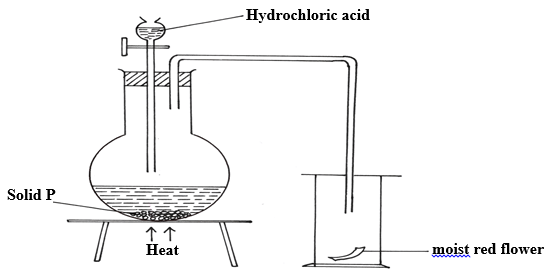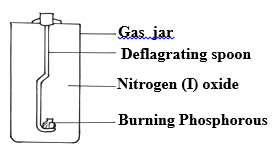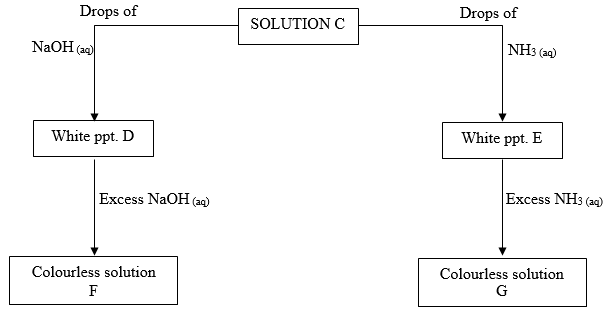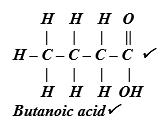INSTRUCTIONS TO CANDIDATES
- Write your name and index number in the spaces provided above.
- Sign and write the date of examination in the spaces provided above.
- Answer ALL the questions in the spaces provided.
- Mathematical tables and electronic calculators may be used.
- All working MUST be clearly shown where necessary.
FOR EXAMINERS USE ONLY
|
Questions |
Maximum Score |
Candidate’s Score |
|
1 – 31 |
80 |
|

Questions
- State and explain the observation made when excess ammonia gas reacts with chlorine gas. (2 marks)
- Hydrogen gas reacts with ethene to form ethane. Calculate the volume of hydrogen required to convert 14g of ethene to ethane at S.T.P. (3 marks)
C2H2 (g) + H2 (g) → C2H6
(C = 12, H = 1, molar gas volume at S.T.P. is 22.4 litres) - The table below shows the relative molecular masses and boiling points of propan-l-ol and Ethanoic acid.
Explain why the boiling point of Ethanoic acid is higher than that of propan –l-ol and yet they have same molecular mass. (2 marks)Relative Molecular Mass
Boiling point (oC)
Propan –l-ol
60
36
Ethanoic acid
60
118
- In an experiment an equal amount of iron fillings and sulphur powder was heated in a test tube. The mixture was left to cool then dilute hydrochloric acid added to it.
- State the observations that were made;
- In the test tube. (1 mark)
- Dilute hydrochloric acid was added to the mixture after cooling. (1 mark)
- Write an equation for the reaction which occurred in a) (ii) above. (1 mark)
- State the observations that were made;
-
- What is meant by double decomposition? (1 mark)
- Starting with 1M sodium sulphate solution, describe how you would prepare dry lead II sulphate. (2 marks)
- 6.84g of aluminium sulphate were dissolved in 200cm3 of water. Calculate the Molar concentrations of the sulphate ions in the solution.(Relative formula mass of aluminium sulphate is 342) (3 marks)
- The diagram below shows the set-up that was used to prepare and collect sulphur (iv) oxide gas.

- Identify solid P (1 mark)
-
- Why is it possible to collect sulphur (IV) Oxide as shown? (1 mark)
- What happened to the red flower. (1 mark)
- The set-up show how small pieces of red phosphorous are heated in Nitrogen (I) Oxide.

- Write an equation for the reactions which occur in the gas jar. (1 mark)
- Give one use of Nitrogen (I) oxide. (1 mark)
- Study the following reactions scheme and answer the questions that follow.

- Identify
- The cations in solution C. (1 mark)
- The white precipitate E. (1 mark)
- Why does precipitate E dissolve in excess sodium hydroxide solution. (1 mark)
- Write the formula of the complex ion formed. (1 mark)
- Identify
- Starting with copper metal, describe how a sample of crystals of copper (II) sulphate is prepared in Laboratory. (3 marks)
- The Set up below shows an experiment where hydrogen gas was passed over heated copper (II) Oxide.

- State and explain the observations made in the combustion tube during the experiment. (3 marks)
- Explain why heat is necessary in this experiment. (1 mark)
-
- State Boyle’s law (1 mark)
- 3 litres of oxygen gas at one atmosphere pressure were compressed to two atmospheres at constant temperature. Calculate the volume occupied by the oxygen gas . (2 marks)
- The table below gives some information about elements J,K,L,M which are in the same group of the periodic table. Use the formation to answer the question that follow.
Element
1st Ionization energy kJmol-1
Atomic radius (nm)
J
K
L
M
520
500
420
400
0.15
0.19
0.23
0.25
- What is meant by ionization energy. (1 mark)
- State and explain the relationship between the variations in the first ionization energies and the atomic radii. (2 marks)
- When a hydrocarbon fuel burn, one of the main products is acidic gas R.
- Identify gas R. (1 mark)
- What effect does gas R have when its concentration in the atmosphere exceeds its acceptable levels. (1 mark)
- The graph below shows a curve obtained when water at 22oC was heated for 10 minutes. Sodium Chloride crystals were added and strongly heated for 15 minutes.

- What happened to water molecules between points A and B? (1 marks)
- Explain why the temperature rise is not steady between points B and C. (2 marks)
- Use the table below to answer the questions that follow.

- Which substances is:
- A soapless detergent. (½ mark)
- An ester (½ mark)
- Give name to substance B. (1 mark)
- Write an equation for the reaction between the structure of substance D and Sodium hydroxide solution. (2 marks)
- Which substances is:
- When hydrated sample of iron (II) sulphate FeSO4.nH2O was heated until there was no further change in mass, the following data was recorded
Mass of evaporating dish = 78.94 g
Mass of evaporating dish + hydrated salt = 84.14 g
Mass of evaporating dish + residue = 81.78 g
Determine the empirical formula of the hydrated salt. (Relative Formula Mass of FeSO4 = 152, H2O = 18) (3 marks) - Study the flow chart below and answer the questions that follow;

- Write an equation for the reaction between gas X and ammonia. (1 mark)
- Write the formulae of the substances present in the mixture Y(aq). (1 mark)
- When hydrogen sulphide gas was bubbled into an aqueous solution of iron (III) chloride, a yellow precipitate was deposited.
- State another observation that would be made. (1 mark)
- Write an equation of the reaction that took place. (1 mark)
- The table below shows the atomic numbers of elements P, Q and R.
Element
P
Q
R
Atomic
13
7
12
- Explain why P and R would not be expected to form a compound. (1 mark)
- Write an equation to show the effect of heat on the carbonate of R. (1 mark)
- Element T consists of two isotopes 62T and 64T in the ratio 7 : 3 respectively. Calculate the relative atomic mass of element T. (3 marks)
- Name the process which takes place when:
- Solid carbon (IV) oxide changes directly into gas. (1 mark)
- An alcohol reacts with alkanoic acid in the presence of sulphuric acid to form a sweet smelling compound. (1 mark)
- Briefly explain how you would obtain pure sample of lead (II) chloride from a mixture of lead (II) chloride and silver chloride. (2 marks)
- Explain the following observations; very little carbon (IV) oxide is evolved when lead carbonate reacts with dilute hydrochloric acid. (2 marks)
- The table below gives some properties of compounds P, Q, R and S
Compound
B.P. (oC)
M.P. (oC)
Conductivity in water
P
77
-23
Does not conduct
Q
74
-19
Does not conduct
R
-161
-185
Conducts
S
2407
714
Conducts
- Which one of the compounds in the table is ionic? Explain. (1 mark)
- Give the compound that is liquid at room temperature. (1 mark)
- When butan – 1 – ol is oxidized by acidified potassium dichromate, a weak organic acid is formed.
Draw and name the structural formula of the acid obtained from the above reaction. (2 marks) - Air was passed through several reagents as shown in the flow chart below.

- Write an equation for the reaction that took place in the chamber with the magnesium powder. (1 mark)
- Name one gas that escapes from the chamber containing magnesium powder. Give a reason for your answer. (1 mark)
- A sisal farmer found that when pricked by a sisal thorn, application of a little solution of ash helped to relieve the pain from the affected area. Explain. (2 marks)
- Explain why aluminium metal is not extracted from aluminium chloride. (2 marks)
- Distinguish between a strong acid and concentrated acid. (2 marks)
- In an experiment to determine the solubility of potassium nitrate at 30oC, a saturated solution was heated in an evaporating dish until there was no further change in mass. The following data was obtained.
Mass of dish + solution = 128.9 g
Mass of dish + dry salt = 103.9 g
Mass of empty dish = 94.3 g
Determine the solubility of potassium nitrate at 30o C. (3 marks)

MARKING SCHEME
- State and explain the observation made when excess ammonia gas reacts with chlorine gas.(2mks)
Observation – white fumes (1mk)
Ammonia is ignited in chlorine to form hydrogen chloride. ½mk. The hydrogen chloride reacts with excess ammonia to form ammonium chloride (½mk) - Hydrogen gas reacts with ethene to form ethane. Calculate the volume of hydrogen required to convert 14g of ethene to ethane at S.T.P. (3 mks)
C2H2 (g) + H2 (g) C2H6
(C = 12, H = 1, molar gas volume at S.T.P. is 22.4 litres)
R.A.M of ethene = 28 ½
Moles of ethene = 14 = 0.5 ½
28
Moles of hydrogen = 0.5 ½ (3 mks)
Volume of hydrogen = 0.5 x 22.4 ½
= 11.2 liter ½ - The table below shows the relative molecular masses and boiling points of propan-l-ol and Ethanoic acid.
Explain why the boiling point of Ethanoic acid is higher than that of propan –l-ol and yet they have same molecular mass. (2mks)Relative Molecular Mass
Boiling point (oC)
Propan –l-ol
60
36
Ethanoic acid
60
118
Ethanoic acid has ability to form hydrogen bonds which are stronger than those of Propan-1-ol. Hence requires more energy to break hydrogen bond in ethanoic acid. (2mks) - In an experiment an equal amount of iron fillings and sulphur powder was heated in a test tube. The mixture was left to cool then dilute hydrochloric acid added to it.
- State the observations that were made;
- In the test tube. (1 mk)
- Red glow ½
- Black /grey solid formed ½
- Dilute hydrochloric acid was added to the mixture after cooling. (1 mk)
- Ggas with a smell of a rotten ½ egg
- Effervescence ½ (3mks)
- In the test tube. (1 mk)
- Write an equation for the reaction which occurred in a) (ii) above. (1 mk)
FeS(s) + 2 HCl(aq) FeCl2(aq) + H2S(s)
- State the observations that were made;
-
- What is meant by double decomposition? (1 mk)
It is a reaction between two soluble salts to give one soluble and one insoluble (precipitate) - Starting with 1M sodium sulphate solution, describe how you would prepare dry lead II sulphate. (2 mks)
Add solution of 1M sodium sulphate to an equal volume of 1M to lead (II) nitrate solution- Filter ½ to obtain Lead sulphate as a residue and sodium nitrote as a filtrate
- Dry ½ the residue with filter papers to obtain the solid lead (II) sulphate (2mks)
- What is meant by double decomposition? (1 mk)
- 6.84g of aluminium sulphate were dissolved in 200cm3 of water. Calculate the Molar concentrations of the sulphate ions in the solution.(Relative formula mass of aluminium sulphate is 342) (3mks)
- Moles of aluminium sulphate = 6.84/342 ( ½ mk)
= 0.02moles ( ½mk)
Concentration of Aluminium sulphate = 0.02 x 1000
200cm3
= 0.01moles ½mk
Conc. of sulphate ions = 0.01x 3 = 0.03M ½
- Moles of aluminium sulphate = 6.84/342 ( ½ mk)
- The diagram below shows the set-up that was used to prepare and collect sulphur (iv) oxide gas.

- Identify solid P (1mk)
- Sodium sulphite (√1mk)
-
- Why is it possible to collect sulphur (IV) Oxide as shown? (1mk)
- Sulphur (IV) oxide is denser than air.
- What happened to the red flower. (1mk)
- It was bleached / turn white(√1mk)
- Why is it possible to collect sulphur (IV) Oxide as shown? (1mk)
- Identify solid P (1mk)
- The set-up show how small pieces of red phosphorous are heated in Nitrogen (I) Oxide.

- Write an equation for the reactions which occur in the gas jar. (1mk)
- P4(s) + 10N2O(g) → 2P2O5(s) + 10N2(g) (1mk)
Penalize: - ½ mk wrong/missing state symbols
Fully unbalanced equation
Fully wrong symbols /formula
- P4(s) + 10N2O(g) → 2P2O5(s) + 10N2(g) (1mk)
- Give one use of Nitrogen (I) oxide. (1mk)
- Manufacture of HNO3 acid (1mk)
- Manufacture of explosives, Nylons and plastics
- Write an equation for the reactions which occur in the gas jar. (1mk)
- Study the following reactions scheme and answer the questions that follow.

- Identify
- The cations in solution C. (1 mk)
- Zn2+ ions
- The white precipitate E. (1 mk)
- Zinc Hydroxide /zn(OH)2
- The cations in solution C. (1 mk)
- Why does precipitate E dissolve in excess sodium hydroxide solution. (1 mk)
- its atmospheric ½ and it reacts with both acids and bases
- Write the formula of the complex ion formed. (1 mk)
- [Zn(NH3)4]2+ 1mk
- Identify
- Starting with copper metal, describe how a sample of crystals of copper (II) sulphate is prepared in Laboratory. (3mks)
- Heat copper metal in air to form oxide of (CuO)
- Add excess CuO (Copper (II) oxide) to dilute sulphuric (VI) acid to ensure all acid has reacted.
- Warm to speed up the reaction
- Filter to obtain copper (II) sulphate solution as the filtrate.
- Evaporate the filtrate over water bath
- Filter and dry the crystals at s.t of between two pieces of filter papers. (accept any correct alt. method)
- The Set up below shows an experiment where hydrogen gas was passed over heated copper (II) Oxide.

- State and explain the observations made in the combustion tube during the experiment. (3mks)
- The hot black CuO turn Red-brown (√ ½mk)
- Colourless liquid condenses and collects on cooler parts of combustion tube. (√ ½mk)
- CuO is reduced by hydrogen to Cu metal (√1mk) While hydrogen is oxidized to water(√1mk)
- Explain why heat is necessary in this experiment. (1mk)
- To drive out the air which might cause reoxidation of Cu. (√ 1mk)
- State and explain the observations made in the combustion tube during the experiment. (3mks)
-
- State Boyle’s law (1 mk)
- The volume of a fixed mass of a gas is inversely proportional to its pressure at constant temperature 1
- 3 litres of oxygen gas at one atmosphere pressure were compressed to two atmospheres at constant temperature. Calculate the volume occupied by the oxygen gas . (2 mks)
- P1V1 = P2V2
1 x3 = 2 x V2
[1 × 3] = V2
2
1.5 = V2
V2 = 1.5 litres
- P1V1 = P2V2
- State Boyle’s law (1 mk)
- The table below gives some information about elements J,K,L,M which are in the same group of The periodic table. Use the formation to answer the question that follow.
Element
1st Ionization energy kJmol-1
Atomic radius (nm)
J
K
L
M
520
500
420
400
0.15
0.19
0.23
0.25
- What is meant by ionisation energy. (1mk)
- Ionization energy is the minimum energy required to remove an electron from the outermost energy level of an atom in the gaseous state. (√1mk)
- State and explain the relationship between the variations in the first ionization energies and the atomic radii. (2mks)
- 1st ionization energy decrease with increase in atomic radii. (√ 1mk)
- When atomic radius increases the outermost electron gets further from the nucleus less energy is thus required to remove it. (√ 1mk)
- What is meant by ionisation energy. (1mk)
- When a hydrocarbon fuel burn, one of the main products is acidic gas R.
- Identify gas R. (1mk)
- R is CO2 or carbon (IV) oxide
- What two effects does gas R have when its concentration in the atmosphere exceeds its acceptable levels. (1mk)
- R leads to global warming / green house effect or acid rain ½
- Identify gas R. (1mk)
- The graph below shows a curve obtained when water at 22oC was heated for 10 minutes.
Sodium Chloride crystals were added and strongly heated for 15 minutes.
- What happened to water molecular between points A and B? (1mk)
- They gain energy and more faster or the gains K.E hence intermolecular distance increases.
- Explain why the temperature rise is not steady between points B and C. (2mks)
- Sodium chloride is an impurity, (√ 1mk), impurities raises the boiling point of water (√ 1mk)
- if impure water boils 100oC over a range of temperature (accept any one which is correct)
- What happened to water molecular between points A and B? (1mk)
- Use the table below to answer the questions that follow.

- Which substances is:
- A soapless detergent. (½mk)
- C (√½mk)
- An ester (½mk)
- B (√½mk)
- A soapless detergent. (½mk)
- Give name to substance B (1mk)
- Propane - 1, 2, 3 –triol (√1mk)
- Write an equation for the reaction between the structure of substance D and Sodium hydroxide solution. (2mks)
- R-COOH + 3NaOH(aq) → 3R-COO-Na+ + 3H2O
OR
R-COOCH2
|
R – COOCH + 3NaOH →3R – COO-Na++3H2O
|
R – COOCH2 (Ignore the state symbols)
- R-COOH + 3NaOH(aq) → 3R-COO-Na+ + 3H2O
- Which substances is:
- When hydrated sample of iron (II) sulphate FeSO4.nH2O was heated until there was no further change in mass, the following data was recorded
Mass of evaporating dish = 78.94 g
Mass of evaporating dish + hydrated salt = 84.14 g
Mass of evaporating dish + residue = 81.78 g
Determine the empirical formula of the hydrated salt. (Relative Formula Mass of FeSO4 = 152, H2O = 18) (3mks)
Mass of FeSO4 = 81.68 - 78.94 = 2.84
Mass of H2O = 84.14 – 81.78 = 2.36
E.F = FeSO4.7H2OFeSO4
H2O
Mass 2.84
RFM 152
Moles 2.84 = 0.0187 ½
152Mole ratio 0.0187 = 1 ½
0.01872.36 P ½
18
2.36 = 0.1311 ½
180.1311 = 7 ½
0.0187 - Study the flow chart below and answer the questions that follow;

- Write an equation for the reaction between gas X and ammonia. (1mk)
- 4NH3 (g) + 5O2 (g) 4NO(g) +6H20(g)
- Write the formulae of the substances present in the mixture Y(aq). (1mk)
- HNO3 ½
- HNO2 ½
- Write an equation for the reaction between gas X and ammonia. (1mk)
- When hydrogen sulphide gas was bubbled into an aqueous solution of iron (III) chloride, a yellow precipitate was deposited.
- State another observation that would be made. (1mk)
- The solution turned from yellow to pale green . 1
- Write an equation of the reaction that took place. (1mk)
- 2FeCl3(aq) + H2S(g) → 2FeCl2(aq) + S(s) + 2HCl(aq) 1
- State another observation that would be made. (1mk)
- The table below shows the atomic numbers of elements P, Q and R.
Element
P
Q
R
Atomic
13
7
12
- Explain why P and R would not be expected to form a compound. (1mk)
- Both are metals would only react by losing electrons. 1.
- Write an equation to show the effect of heat on the carbonate of R. (1mk)
- RCO3(s) → RO(s) + CO2(g)
- Explain why P and R would not be expected to form a compound. (1mk)
- Element T consists of two isotopes 62T and 64T in the ratio 7 : 3 respectively. Calculate the relative atomic mass of element T. (3mks)
- RAM = 7 × 62 + 3 × 64
10 10
= 43.4 + 19.2
= 62.6
- RAM = 7 × 62 + 3 × 64
- Name the process which takes place when:
- Solid carbon (IV) oxide changes directly into gas. (1mk)
- Sublimation
- An alcohol reacts with alkanoic acid in the presence of sulphuric acid to form a sweet smelling compound. (1mk)
- Esterification
- Solid carbon (IV) oxide changes directly into gas. (1mk)
- Briefly explain how you would obtain pure sample of lead (II) chloride from a mixture of lead (II) chloride and silver chloride. (2mks)
- Add warm water to the mixture and stir ½
- PbCl2 dissolves while AgCl does not ½
- Filter to obtain PbCl2 as filtrate and AgCl as residue ½
- Evaporate the filtrate to obtain solid PbCl2 ½
- Explain the following observations; very little carbon (IV) oxide is evolved when lead carbonate reacts with dilute hydrochloric acid. (2mks)
- PbCO3 reacts with dilute HCl(aq) to form an insoluble coat of PbCl2 on the carbonate which stops further reaction
- The table below gives some properties of compounds P, Q, R and S
Compound
B.P. (oC)
M.P. (oC)
Conductivity in water
P
77
-23
Does not conduct
Q
74
-19
Does not conduct
R
-161
-185
Conducts
S
2407
714
Conducts
- Which one of the compounds in the table is ionic? Explain. (1mk)
- S ½
- It has high mp and bp due to strong ionic bonds/is a good conductor in aqueous form
- Give the compound that is liquid at room temperature. (1mk)
- P or Q (Any one) 1
- Which one of the compounds in the table is ionic? Explain. (1mk)
- When butan – 1 – ol is oxidized by acidified potassium dichromate, a weak organic acid is formed.
Draw and name the structural formula of the acid obtained from the above reaction. (2mks)
- Air was passed through several reagents as shown in the flow chart below.

- Write an equation for the reaction that took place in the chamber with the magnesium powder. (1mk)
- 3Mg(s) + N2 (g) Mg3N2 (s)
- Name one gas that escapes from the chamber containing magnesium powder. Give a reason for your answer. (1mk)
- Argon – It is inert
- Write an equation for the reaction that took place in the chamber with the magnesium powder. (1mk)
- A sisal farmer found that when pricked by a sisal thorn, application of a little solution of ash helped to relieve the pain from the affected area. Explain. (2mks)
- Sisal thorns contain an acid ½ which causes pains ½. Ash solution being alkaline ½ neutralizes the acid lessening the pain ½
- Explain why aluminium metal is not extracted from aluminium chloride. (2mks)
- AlCl3 is largely covalent 1
- It is made of molecules which don’t conduct electricity
- Distinguish between a strong acid and concentrated acid. (2mks)
- A strong acid is one which ionizes completely in water to produce higher concentration of hydrogen ions. While concentrated acid is one which contains higher number of acid molecules per given volume of water.
- In an experiment to determine the solubility of potassium nitrate at 30oC, a saturated solution was heated in an evaporating dish until there was no further change in mass. The following data was obtained.
Mass of dish + solution = 128.9 g
Mass of dish + dry salt = 103.9 g
Mass of empty dish = 94.3 g
Determine the solubility of potassium nitrate at 30º C. (3mks)- Mass of solution = 128.9 – 94.3g = 34.6g ½
- Mass of dry salt = 103.9 – 94.3 = 9.6g ½
- Mass of solvent = 34.6 – 9.6 = 25g ½
- 25.0g of solvent contain 9.6g of solute
- 100g of solvent contain = 9.6 × 100 1
25.0 - Solubility = 38.4g/100g water ½
Download Chemistry P1 Questions and Answers - Wisdom Pre-Mock Form 4 Exams 2021/2022.
Tap Here to Download for 50/-
Get on WhatsApp for 50/-
Why download?
- ✔ To read offline at any time.
- ✔ To Print at your convenience
- ✔ Share Easily with Friends / Students

